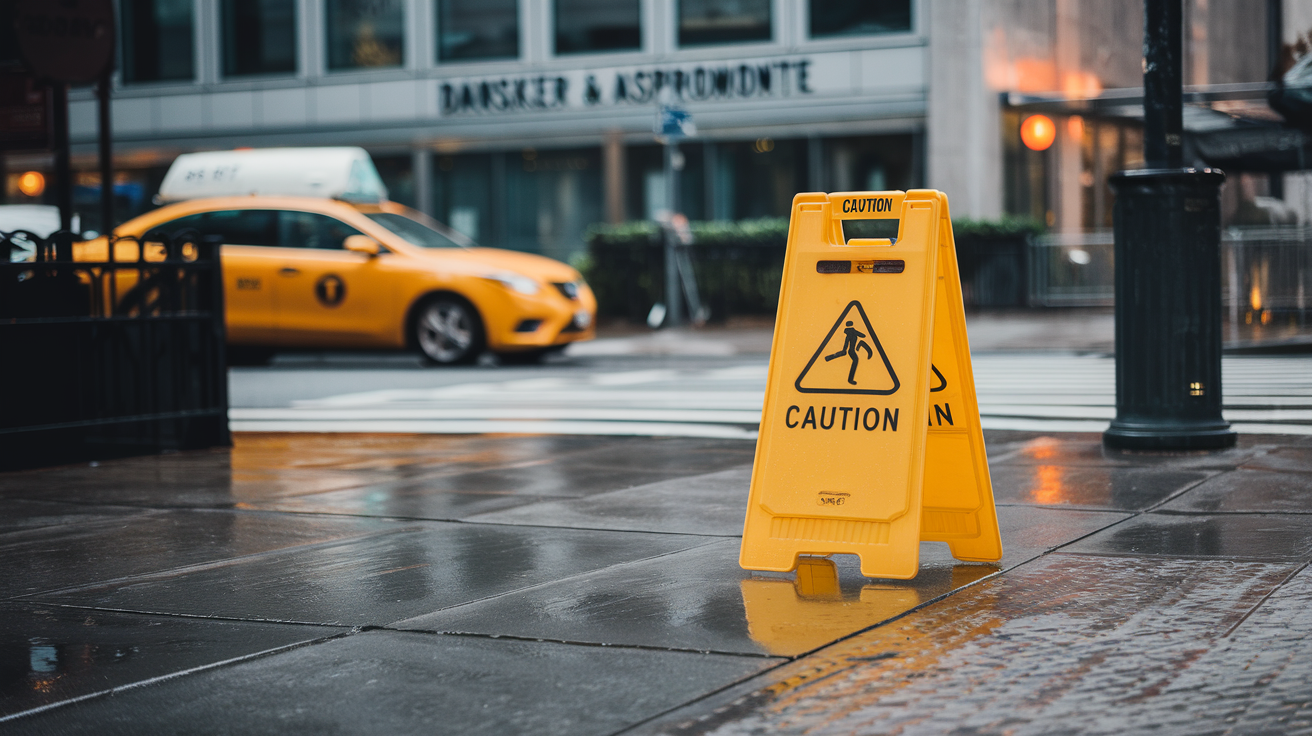Slip and falls in New York City are a serious problem, often leading to severe injuries or even fatalities. According to the Centers for Disease Control and Prevention (CDC), unintentional falls are a leading cause of injury-related deaths among older adults.
In legal terms, a slip and fall case is a type of negligence action brought by a personal injury victim who has suffered damages due to such an accident. To recover compensation, the victim must prove that another party—whether an individual or a legal entity—was responsible for creating or failing to address the unsafe condition that caused the fall.
New York City’s premises liability laws specify the duty of property owners and occupiers to maintain safe sidewalks and walkways for pedestrians. If you’ve been injured in an NYC slip and fall accident, seeking legal assistance can increase your chances of securing adequate compensation for your injuries and avoiding out-of-pocket medical expenses.
Clarifying Premises Liability
Anyone who owns, maintains, or occupies property in NYC should have a firm grasp on premises liability concepts. Premises liability is the legal concept that determines who can be held liable when a visitor is injured on someone else’s property. Depending on the scenario, premises liability laws establish who must pay for a victim’s damages following a slip and fall accident.
In New York, property owners must keep their property reasonably safe for visitors. For example, if a sidewalk becomes icy after a snowstorm or an overnight freeze, property owners who know or should know about the hazard must take steps to address it. Reasonable actions might include spreading sand for traction or shoveling snow to make the sidewalk visible and safe.
This “reasonable person” standard of care has long been established in New York. While some states differentiate between types of visitors to determine the level of care owed, New York does not make such distinctions.
In the seminal case of Basso v. Miller (N.Y. 1976), the Court of Appeals adopted a single reasonable standard of care based on the foreseeability of harm to entrants. This decision simplified premises liability law to align with modern society and prevent inconsistent jury verdicts.
Additionally, New York City’s Administrative Code § 7-210 requires property owners to maintain sidewalks adjoining their property in a reasonably safe condition. Failure to comply with this requirement can result in liability for injuries caused by hazards like broken pavement, snow, ice, or debris.
Comparative Negligence and Premises Liability
New York follows a “comparative negligence” standard for personal injury cases, including slip-and-fall incidents. Under N.Y. CPLR 1411, even if an injured person is partially at fault for their accident, they can still recover compensation. However, their award will be reduced by the percentage of their fault.
Often, both parties share blame for an accident. This law strikes a balance by allowing injured parties to recover damages while holding them accountable for their own actions.
For example, an intoxicated pedestrian might decide to run home after a night out instead of using a taxi or rideshare. If the pedestrian slips on black ice outside a property owner’s home, a jury might determine that both the pedestrian and the property owner share responsibility. The jury could assign 70% fault to the property owner for failing to address the icy conditions and 30% to the pedestrian for their reckless behavior. In this case, if the pedestrian’s damages total $100,000, they would receive $70,000, reflecting the property owner’s share of liability.
Steps to Take Following an NYC Slip and Fall Accident
Taking the proper steps after a slip and fall can protect your legal claim and improve your chances of success when negotiating with insurance companies or during litigation. If you’ve been injured in a slip and fall, you should:
- Seek medical attention immediately. Even minor injuries may mask more serious issues, such as a concussion. Medical records create a clear link between your accident and injuries, which is critical for proving your case. Learn more about injury documentation from the CDC.
- Document the scene. Take photos or videos of the hazard that caused your fall. Capture details like icy patches, wet floors, or broken pavement. If an incident report is completed, ask for a copy.
- Gather witness information. If anyone saw the accident, get their contact details and, if possible, a brief statement. Witness accounts can corroborate your version of events.
- Keep thorough medical records. Save all doctor’s notes, imaging results, physical therapy records, and any related documentation. These establish the severity of your injuries and help validate your claim. Additional guidance is available from Findlaw.
- Consult an attorney. A premises liability lawyer can navigate the legal process, handle insurance negotiations, and build a strong case on your behalf. Legal guidance significantly increases your likelihood of recovering adequate compensation. The American Bar Association provides resources to locate qualified attorneys.
Who is Liable For My NYC Slip and Fall?
Identifying who is liable is a critical step in a slip and fall claim. The location of the accident often determines responsibility. Liability may fall on a private owner, property manager, government entity, or even a construction company. In many cases, bringing a claim against multiple parties is the best course of action.
For private property, NYC Administrative Code § 7-210 places the responsibility on property owners to maintain adjacent sidewalks and walkways. Failing to repair cracks, remove ice, or address other hazards can result in liability if an injury occurs. Property managers may also share responsibility if they are contractually obligated to handle maintenance.
When an accident occurs on public property, such as a subway platform or crosswalk, government entities may be liable. In these cases, victims may need to file specific legal documentation to preserve their right to seek compensation. Consulting an attorney promptly ensures all procedural requirements are met. Resources such as the New York Courts Help Center can provide additional guidance.
Construction companies or contractors could be liable for your injuries if they’re responsible for hazardous conditions like defective sidewalk sheds, debris, or poor lighting in areas under their control.
Common Slip and Fall Injuries
Slip and fall accidents can cause a wide range of injuries, from minor discomfort to life-altering conditions. Many victims require extensive medical treatment and rehabilitation. Common injuries include:
- Broken bones
- Spinal cord injuries
- Traumatic brain injuries
- Soft tissue injuries
- Cuts and lacerations
Severe trauma increases the risk of long-term consequences that can disrupt daily life. For example, a broken wrist might make it difficult to cook, clean, or care for your family. Likewise, a serious back or neck injury could prevent you from working or enjoying your usual hobbies.
Fortunately, the law recognizes the profound impact such injuries can have on a victim’s life. Compensation is available to help victims recover and rebuild after a slip and fall. For more information on injury treatment and recovery, consult the New York State Department of Health.
What Types of Compensation are Available for Slip and Fall Victims?
The law allows injured parties to seek damages to offset the losses caused by a slip and fall injury. While every case is unique, common types of compensation include:
- Medical Expenses: Covers hospital bills, emergency transportation, prescription costs, physical therapy, and future medical care. Learn more about medical expenses and injury recovery from Finance Monthly.
- Lost Wages: Recoups earnings lost due to time away from work. Guidance on calculating lost wages can be found at Findlaw.
- Pain and Suffering: Addresses physical pain, emotional distress, and diminished enjoyment of life. These damages are subjective and vary by case.
- Loss of Earning Capacity: Compensates for reduced ability to work or advance in your career due to injuries.
- Out-of-Pocket Costs: Includes transportation to medical appointments, childcare, and other expenses related to the accident.
Compensation is designed to help victims recover and rebuild their lives. The extent of your injuries and their impact on your daily life will influence the amount you can recover. An experienced attorney can guide you through the process and ensure you pursue all available damages.
Working With a NYC Personal Injury Lawyer
Initial Steps
Working with a personal injury attorney can help you confidently approach recovery. The process begins with an initial consultation, where you and the attorney discuss the facts of your case. If the attorney determines your claim is viable, they will gather evidence to build a solid foundation. This may include obtaining incident reports and consulting experts to assess hazardous conditions related to your accident.
Your attorney may approach the property owner’s insurance carrier with a settlement demand. Early negotiations can sometimes resolve the case quickly if the insurer offers a fair settlement. However, talks may stall if liability is disputed or the extent of your injuries is contested.
If negotiations fail, your attorney will file a formal lawsuit by submitting a Summons and Complaint in court. The defendant(s) will then respond by admitting or denying the allegations and potentially shifting blame to other parties. For more information on filing a lawsuit, visit the New York State Unified Court System.
Litigation
During the litigation phase, both sides engage in discovery—a process of exchanging documents, requesting information on medical treatments, and conducting depositions under oath. Depositions clarify what witnesses, plaintiffs, and defendants might testify at trial.
Expert testimony often plays a critical role. For example, an engineer might explain a defective design, while a medical expert connects your injuries to the accident. While discovery can be time-consuming and costly, it is essential for establishing the facts. For more details on the discovery process, consult the United States Courts Rulemaking Process.
As discovery concludes, the court may schedule settlement conferences or suggest mediation to encourage compromise and avoid trial. A neutral mediator might weigh in on the strengths and weaknesses of each side’s case. Learn more about mediation from the New York State Courts Alternative Dispute Resolution Program.
Meanwhile, your attorney will prepare for potential motions, such as a motion for summary judgment. This motion seeks a ruling without trial if the evidence clearly establishes liability. Guidance on summary judgment motions is available at the Legal Information Institute (Cornell Law School).
Trial
If the case proceeds to trial, jury selection is the first step. Both sides aim to seat jurors who can evaluate evidence impartially.
The trial begins with opening statements, followed by witness testimony, expert analysis, and cross-examinations. Each side presents evidence to support their claims and challenge opposing arguments.
After closing arguments, the judge instructs the jury on the applicable laws before they deliberate and reach a verdict. If the jury finds the defendant liable, they will determine the compensation amount.
The losing party may file post-trial motions to adjust damages or request a new trial. Appeals are also possible if legal errors are alleged. For more information on the appeals process, visit the United States Courts Appeals Overview.
How Much Does a Personal Injury Attorney Cost?
Most NYC personal injury lawyers work on a contingency basis. This arrangement means you pay no upfront legal fees. Instead, your attorney receives an agreed-upon percentage of any settlement or court award. These percentages must always be reasonable.
Hiring an attorney is particularly beneficial when you’ve suffered significant harm in a slip and fall. Acting swiftly allows your lawyer to gather fresh evidence and prevent you from making statements to insurance adjusters that could harm your claim. Acting promptly after an accident is crucial to protect your legal rights, as there are time limits on filing lawsuits for personal injury claims.
People Also Ask
- Is a slip and fall case a negligence case? Yes, a slip and fall case typically involves proving negligence. This requires showing that a property owner or responsible party failed to keep their property reasonably safe. Consulting an experienced attorney can simplify this complex process. Learn more about negligence at the Legal Information Institute (Cornell Law School).
- What if the accident was partially my fault? Under New York’s comparative negligence law, you can recover damages even if you share fault for the accident. However, your compensation will be reduced by your percentage of fault. Read about comparative negligence at the New York Senate’s Civil Practice Law and Rules § 1411.
- How long does the legal process take? The length of a case varies. It can take a few months to several years, depending on factors like the case’s complexity, the number of parties involved, and whether it settles early or proceeds to trial. For guidance on legal timelines, visit the United States Courts Overview.
- Can I sue multiple parties for my accident? Yes. If multiple parties are responsible, you can take legal action against all of them. An attorney can identify all liable parties and help you maximize your compensation. Learn more about multi-party liability at FindLaw.
Trust the Professionals to Handle Your NYC Slip and Fall
If you’ve been injured in a NYC slip and fall, Dansker & Aspromonte can help you get the compensation you deserve. We’ve recovered over half a billion dollars for personal injury clients and are committed to fighting for justice.
Don’t let insurance companies undervalue your claim. Contact us online or call (516) 774-3988 to discuss your legal options today.






